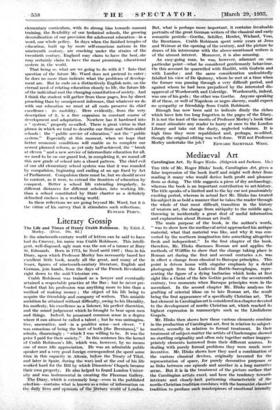Mediaeval Art
Carolingian Art. By Roger Rinks. (Sidgwick and Jackson. 15s.) THE title of Mr. Roger Hinks' book, Carolingian Art, gives a false impression of the book itself and might well deter from reading it many who would 'derive both profit and pleasure from so doing. The title suggests a piece of dry archaeology, whereas the book is an important contribution to art-history. The title speaks of a limited and to the lay ear not passionately exciting period, whereas in actual fact Mr. Rinks has treated his subject in so bold a manner that he takes the reader through the whole of that most difficult transition in the history of western art, the change from antiquity to the middle ages, throwing in incidentally a great deal of useful information and explanation about Roman art itself.
The main purpose of the book, in the author's words, " was to show how the mediaeval artist approached his antique material, what that material was like, and why it was con- verted by the northern imagination into something altogether fresh and independent." In the first chapter of the book, therefore, Mr. Hinks -discusses Roman art and applies the methods of Wolfflin to show that the change taking place in Roman art during the first and second centuries A.D. was in effect a change from classical to Baroque principles.--- This point is driven home with singular emphasis by a detail photograph from the Ludovisi Battle-Sarcophagus, repre- senting the figure of a dying barbarian which looks at first sight like a Christ of the late Gothic period or the seventeenth century, two moments when Baroque principles were in the ascendant. In the second chapter Mr. Hinks- analyses the grafting of oriental ideas on to late Roman art, the result being the first appearance of a specifically Christian art. The last element in Carolingian art is considered in a chapter devoted to the development of nordic Christian art, which reached its highest expression in manuscripts such as the Lindisfarne Gospels.
Mr. Hinks then shows how these various elements combine in the production of Carolingian art, first in relation to subject- matter, secondly in relation to formal treatment. In their treatment of subject-matter the artists of Charlemagne showed no startling originality and often mix together rather inappro- priately elements borrowed from their different sources. In dealing with purely formal problems they were much more inventive. Mr. Rinks shows how they used a combination of the various classical devices, originally invented for the representation of space, for purely decorative purposes or
as links- between one episode and another in a long narrative Wen& , But it is in the treatment of the picture surface •that
the Carolingian artists excel, and here the tendency towards intricate and closely-knit patterning characteristic of the nordic-Christian tradition combines with the humanist classical tradition to produce such masterpieces of emotional intensity as the ivory. panel at Darmstadt, reproduced by Mr. Rinks, in which the human -figures --are contorted, into a tense and excited mass, as if they were the snake-birds-of the Lindisfarne Gospels. The other qualities typical of Carolingian art are also analysed by Mr, Minks—their love of -linear effects, their respect for their-material and their perfect fusion of image and ornament.
In general Mr. Rinks relates the various developments of style to the historical and social background, and thereby makes these developments the more comprehensible. But we find it hard to believe that he has found the right explana- tion, in one particular ease, when he attributes the sudden revival of the antique style in the time of Charlemagne to the personal influence of Einhard. This would seem almost as rash as attributing the classicism of France in the seventeenth century to the personal influence of Poussin. In both cases the work of the individual could only take root if there already existed some general cultural predisposition or some social state which made classicism palatable. In the case of Charle- magne the necessary condition is presumably supplied by the return to a kind of Imperialism based at any rate in its general outlines on that of Rome. Apart from such a minor criticism, we have only one complaint about the book., namely that it needs and deserves far fuller illustration. But presumably the blame for this goes not to the author, nor even to the publisher, but to the public, which cannot be counted on to buy even so admirable a work in sufficient quantities to justify a more luxurious publication. Ax noriv Buarr.







































 Previous page
Previous page